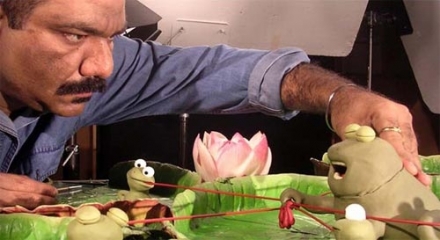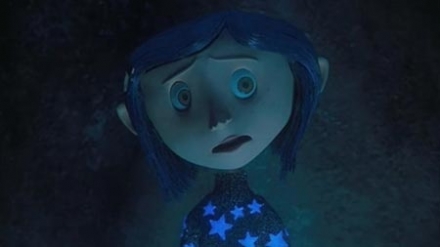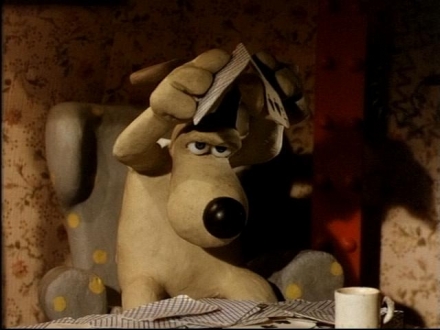GeekBomb: A Brief History Of Stop-Motion Animation
Editor's Note: This is the debut post by Kevin Kelly, who will be offering his expertise in geekdom in a new /Film daily blog feature called GeekBomb. Welcome Kevin to /Film!
Neil Gaiman's Coraline opens this weekend, and it's directed by Henry Selick, one of the few modern masters of stop-motion animation. Although he was trained as a traditional animator, he really came to fame with stop-motion, having directed The Nightmare Before Christmas, James and the Giant Peach, and Monkeybone. In the day and age of everything being whipped up in CGI, it's really a testament to see people work in a medium that requires hours of tedious work on films that can take an extremely long time to produce. Which is why the Sundance opening night film Mary & Max was such a treat.
Whenever someone mentions stop-motion, most people tend to think of one of the above movies, or the equally excellent Chicken Run or Wallace & Gromit: Curse of the Were-Rabbit, both co-directed by the amazing Nick Park. And just to be clear, I'm not calling Monkeybone excellent... but the stop-motion moments are pretty damned awesome. You just have to love a naughty monkey sometimes. Even though most of those films are fairly recent, stop-motion animation has been around in one form or another for more than one hundred years. Click through for the highlights and milestones of this under appreciated art form.
Persistence of Vision
If you want to get down to the brass tacks, nitty-gritty of everything, anything shot on film or video is actually stop-motion animation. You have a series of frames with each one being slightly different than the next, and when you display them at a steady rate of speed, the human eye perceives this as being in fluid motion due to the phenomenon known as persistence of vision. In simple terms, the brain's opto-chemical reactions are much slower than the speed of light, so the eye retains images shown even for a split second, and when the next image is shown, the brain stitches them together seamlessly. So what was once just a series of static images becomes a moving image across your eyes.
This is much more apparent when working with traditional 2D drawn animation. Animators would have to put down a single drawing, take a photo (normally two: images in old-school animation tended to be one image for two frames) with the film camera, replace that drawing with another, and so on. That's your basic operation for drawn and cel animation. Filming a live subject and an animated film with both result in the same final product: a series of images, each slightly different than the next. Stick 'em through a projector, and you've got got what looks like a moving image.
Object Animation
Object manipulation is the earliest form of stop-motion animation, and involves photographing an object and moving it a tiny bit, and then photographing it again. Although this is very time-consuming, it's also one of the easiest forms of stop-motion, although it quickly becomes complex when you're dealing with multiple objects and trying create unique paths and events for each different object.
The first example of object manipulation and stop-motion animation was the 1898 short film by Albert E. Smith and J. Stuart Blackton called The Humpty Dumpty Circus. Unfortunately the film has long since been considered lost, and only information about it exists today. The duo took used some of Blackton's son's circus toys, and photographed them moving around frame by frame. Since that one can't be found, the next surviving example is the short Fun In A Bakery Shop, director by Edwin S. Porter and released in 1902 by Thomas A. Edison. Yes, the same guy who gave us the light bulb. You can check it out below.
This is actually a combination of object manipulation and stop-action photography, where filming is halted and something is changed in the shot before filming resumes. Think Bewitched or I Dream of Jeannie, where the magic would happen, like an elephant appearing in the room. The camera would stop, actors would "freeze," and filming would resume, making it look like the pachyderm had just appeared there. In the above short, which definitely doesn't hold up after all these years, they're stopping the motion so the baker appears to be instantaneously making all of those faces out of dough.
Direct Manipulation Animation
This is a process similar to standard animation, but rather than changing each image entirely, only a portion of the image is erased or added to in-between each frame. One of the earliest examples of this form of animation is also from J. Stuart Blackton. Humorous Phases of Funny Faces was put out by the Edison company in 1906, and it features chalk faces being animated frame by frame, which means Blackton was doing just a bit of the drawing, photographing that image, adding to it and photographing again, and so on. It's considered to be the first world's first animated film, and gave Blackton the distinction of being the "father of American animation." You can check this short out right here.
Puppet Animation
Not long after object animation appearted, filmmakers began experimenting with using different forms of objects that were easier to manipulate. Puppets were one solution, which led to the popular rise of stop-motion animation known as puppet animation. Although technically still objects, puppets were easier for the animators to manipulate and personify, and without it we wouldn't have filmmakers like Willis O'Brien, Ray Harryhausen, Jan Švankmajer, The Brothers Quay, Henry Selick, or the entire Rankin Bass holiday series, including Rudolph the Red-Nosed Reindeer. For a good example of some creepy cool puppet animation, check out Street of Crocodiles by the Brothers Quay below.
One important note is that both stop-motion and puppet animation gave rise to legendary special effects artists and filmmaker Willis O'Brien, who helped pioneer special effects in filmmaking by utilizing stop-motion animation. Initially he used clay to make models for his stop-motion short films, but he soon began developing full armature skeletons and putting rubber skin and fur over them. This is how he came to create the iconic stop-motion shots of King Kong atop the Empire State Building.
O'Brien's work inspired his young assistant Ray Harryhausen who followed in his footsteps by creating sequences and films that further blended stop-motion model/puppet animation with live-action footage. One of his finest pieces of work was the sequence in Jason and the Argonauts featuring a fight with seven skeletal warriors who are all performed via stop-motion animation. Not too shabby for 1963. He did his last stop-motion work for the film Clash of the Titans in 1981. You can check out the skeleton fight from Argonauts right here.
Both O'Brien's and Harryhausen's work has inspired filmmakers like Steven Spielberg, George Lucas, Will Vinton, Peter Jackson, Art Clokey, Tim Burton, and more. In fact, if you visit the LucasFilm / LucasArts building in San Francisco, there's an enormous statuesque monument to O'Brien standing in the lobby.
Pixilation
This is a live-action form of stop motion, which uses actual people being posed frame by frame instead of inanimate objects or drawings. The earliest known example of this is from 1911 in the short film Jobard Cannot See The Women Working, and it's truly a bizarre form of stop-motion animation, especially when used to make people seem like they're flying or levitating. An extremely strange (and amazing) feature film was made in 1993 by the Bolex Brothers using this technique, and you can see part one of The Secret Adventures of Tom Thumb below.
Another filmmaker obsessed with this technique is the truly eccentric and wonderful Mike Jittlov, who created a pixilation charted called The Wizard of Speed and Time. This was from a short film created by Mike Jittlov, a animator who had previously made a short for the Walt Disney Company in 1978 called Mouse Mania, featuring object animation. In 1979, Jittlov directed (and starred as the title character) a short film called The Wizard of Speed and Time for Disney's Major Effects television special. Ten years later, Jittlov directed a feature film version of The Wizard. It's truly bizarre and amazing, and although a DVD of it hasn't been released, you can find a fan-created DVD image of it on peer to peer sites. Here's the short version of the film.
Claymation
Probably the most people commonly associate with stop-motion animation, claymation has been around since at least 1908, when the short film The Sculptor's Nightmare wowed audiences and then four years later when Modeling Extraordinary did the same. These films started appearing more and more frequently because in 1897 an art teacher in the UK had invented plasticine: a non-drying clay that was easily malleable and would retain its shape well. Since it was easy to sculpt and manipulate, filmmakers soon found themselves using this instead of simply moving objects around and photographing them for their subjects.
Eventually animators started putting plasticine on top of wire-armature skeletons, which allowed them to move their models around with even more ease. This is the style of claymation that you see with Wallace & Gromit, Gumby, and even The California Raisins. Interestingly, the term "claymation" is actually a registered word, held by filmmaker Will Vinton, who created the anthropomorphic Raisins. He copyrighted the term in 1978 to refer to his films, although now it's generally recognized as the generic term to refer to plasticine / clay animation.
The rise in popularity of claymation accelerated through the late 70s, when Vinton and Aardman Studios started producing his short claymation films, through the 1980s which gave us the world's first stop-motion animated film in Will Vinton's Adventures of Mark Twain. The 1980s also saw the appearance of of Wallace & Gromit for the first time. Although they starred in a series of shorts, they finally had their feature film debut with Curse of the Were-Rabbit in 2005, although they were pre-dated by Chicken Run in 2000 as Aardman and Dreamworks' first feature-length claymation film. Interestingly enough, Nick Park of Aardman and Wallace & Gromit fame did stop-motion claymation animation for Peter Gabriel's "Sledgehammer" music video, which features object animation, direct manipulation animation, claymation, and pixilation.
So where does that leave us? 2009 has already opened with the first ever full-length feature film selected for Sundance with the Mary & Max, and this weekend's Coraline was the first stop-motion film ever shot in 3D. Aardman Studio has a four-picture deal with Sony to produce more claymation films, Robot Chicken is extrmely popular on television, and Wallace & Gromit just had a new 30 minute short that debuted on BBC One this past Christmas Day. Despite the love-affair that Hollywood has with computers, CGI, and Pixar, stop-motion animation seems to be alive and well. It's at art form that can truly be described as a labor of love, due to the sheer amount of detail, hard work, and dedication that goes into it, and hopefully it will be around for a long time to come.


